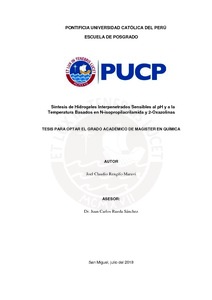| dc.contributor.advisor | Rueda Sánchez, Juan Carlos | |
| dc.contributor.author | Rengifo Maravi, Joel Claudio | es_ES |
| dc.date.accessioned | 2018-09-04T15:43:45Z | es_ES |
| dc.date.available | 2018-09-04T15:43:45Z | es_ES |
| dc.date.created | 2018 | es_ES |
| dc.date.issued | 2018-09-04 | es_ES |
| dc.identifier.uri | http://hdl.handle.net/20.500.12404/12576 | |
| dc.description.abstract | La presente tesis trata sobre la síntesis y caracterización de los hidrogeles
interpenetrados (IPN) sensibles a la temperatura y al pH, compuestos por una primera
red polimérica basada en N-isopropilacrilamida (NiPAAm) (termosensible) y una
segunda red polimérica basada en macromonómero de 2-oxazolina y acrilamida
(sensible al pH).
Estos hidrogeles IPN se sintetizan en tres etapas. Primeramente, se sintetiza el
hidrogel de NiPAAm por polimerización radicalaria de una solución acuosa de
NiPAAm en presencia de la N,N’-metil-bisacrilamida (BIS) como agente entrecruzante.
Después se sintetiza la segunda red polimérica mediante una polimerización radicalaria
de la acrilamida y un macromonómero de 2-oxazolina (MM), el cual es un copolímero
estadístico de 2-metil-2-oxazolina (MeOXA) y 2-carboxietil-2-oxazolina (EsterOXA),
en presencia de la primera red polimérica de NiPAAm. Finalmente, se realiza la
hidrólisis básica de los grupos ésteres presentes en el hidrogel IPN.
Se caracteriza al hidrogel IPN por diferentes métodos. La absorción de agua y la
sensibilidad del hidrogel IPN a diferentes pH y temperaturas se determina mediante el
peso de los hidrogeles en diferentes condiciones. La caracterización estructural se
realiza por espectroscopia infrarroja con transformada de Fourier (FTIR) mediante la
técnica de reflectancia total atenuada (ATR) y por resonancia magnética nuclear de
protón (1H-RMN) en el modo de alta resolución con ángulo mágico (HR-MAS). Su
comportamiento mecánico se estudia mediante el análisis mecánico dinámico de
compresión (AMC).
La caracterización estructural demuestra la formación del hidrogel IPN. La
sensibilidad a la temperatura del hidrogel IPN se debe a la presencia del PoliNiPAAm,
conforme aumenta la cantidad molar del NiPAAm, disminuye la temperatura de
transición conformacional, aumentando la contracción del hidrogel. Mientras que la
sensibilidad al pH del hidrogel IPN se debe a la presencia de los grupos carboxilatos de
la segunda red polimérica, el hidrogel a pH bajos se contrae y a pH altos se expande. | es_ES |
| dc.description.abstract | The present thesis is about the synthesis and characterization of interpenetrated polymer
network (IPN) hydrogels of sensitive temperature and sensitive pH, composed of a first
polymer network based on N-isopropylacrylamide (NiPAAm) (thermosensitive) and a
second polymer network based on macromonomer of 2-oxazoline and acrylamide (ph
sensitive).
These IPN hydrogels are synthesized in three steps. Firstly, the NiPAAm hydrogel is
synthesized by free radical polymerization in an aqueous NiPAAm solution in presence
of N,N´-methyl-bisacrylamide (BIS) as crosslinking agent. After the second polymer
network is synthesized by free radical polymerization of acrylamide and
macromonomer (MM) of 2-oxazoline, which is a statistical copolymer of 2-methyl-2-
oxazoline (MeOXA) and 2-carboxyethyl-2-oxazoline. (EsterOXA), in the presence of
the first NiPAAm polymer network. Finally, the ester groups present in the IPN
hydrogel is hydrolyzed.
The IPN hydrogel is characterized by different methods. Hydrogel swelling and the
sensitivity of the IPN hydrogel at different pH and temperatures is determined by the
weight of the hydrogels under different conditions. The structural characterization by
Fourier transform infrared spectroscopy (FTIR) the technique of attenuated total
reflectance (ATR) and proton nuclear magnetic resonance (1H-RMN) by highresolution
magic-angle-spinning (HR-MAS). The mechanical behavior is studied
through dynamic mechanical analysis (DMA).
The structural characterization demonstrates formation of the IPN hydrogel. The
sensitivity to temperature of the IPN hydrogel is due to presence of PoliNiPAAm, just
as the molar amount of NiPAAm increases, decreases the conformational transition
temperature; raise the contraction of the hydrogel. While the pH sensitivity of the IPN
hydrogel is due to presence of the carboxylate groups of the second polymer network, at
down pH the hydrogel contracts and at high pH the hydrogel expands. | es_ES |
| dc.description.uri | Tesis | es_ES |
| dc.language.iso | spa | es_ES |
| dc.publisher | Pontificia Universidad Católica del Perú | es_ES |
| dc.rights | info:eu-repo/semantics/openAccess | es_ES |
| dc.rights.uri | http://creativecommons.org/licenses/by-nc-nd/2.5/pe/ | * |
| dc.subject | Hidrogeles | es_ES |
| dc.subject | Resonancia magnética nuclear | es_ES |
| dc.subject | Polímeros | es_ES |
| dc.title | Síntesis de hidrogeles interpenetrados sensibles al pH y a la temperatura basados en N-isopropilacrilamida y 2-Oxazolinas | es_ES |
| dc.type | info:eu-repo/semantics/masterThesis | es_ES |
| thesis.degree.name | Magíster en Química | es_ES |
| thesis.degree.level | Maestría | es_ES |
| thesis.degree.grantor | Pontificia Universidad Católica del Perú. Escuela de Posgrado | es_ES |
| thesis.degree.discipline | Química | es_ES |
| renati.advisor.dni | 08948955 | |
| renati.discipline | 531057 | es_ES |
| renati.level | https://purl.org/pe-repo/renati/level#maestro | es_ES |
| renati.type | http://purl.org/pe-repo/renati/type#tesis | es_ES |
| dc.publisher.country | PE | es_ES |
| dc.subject.ocde | https://purl.org/pe-repo/ocde/ford#1.04.00 | es_ES |






